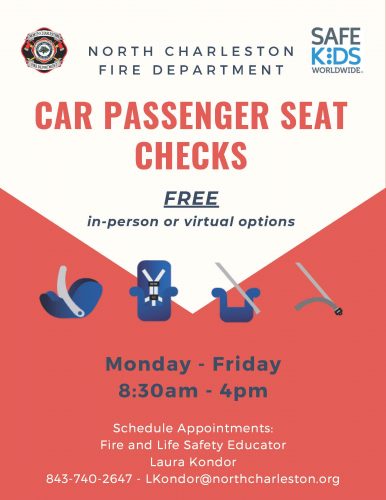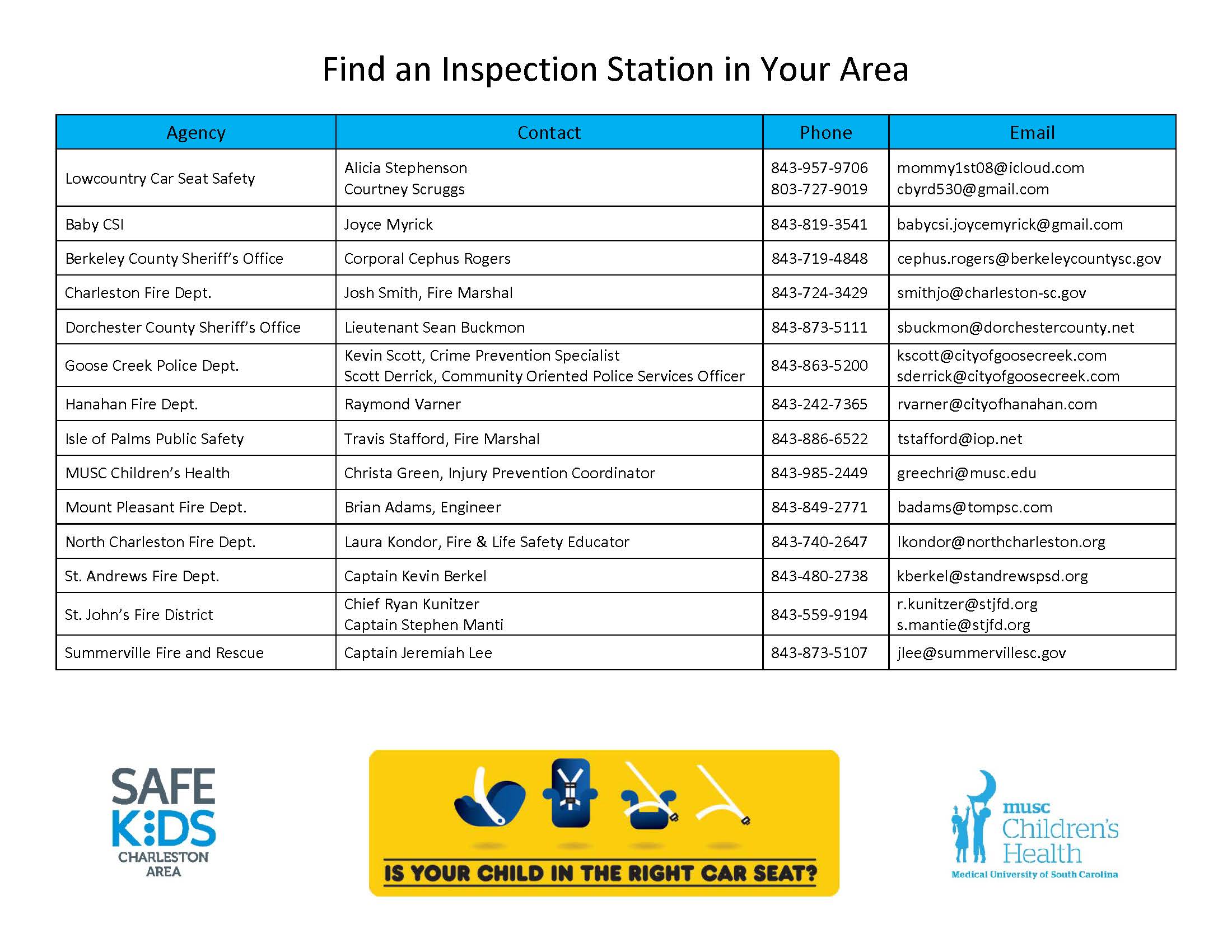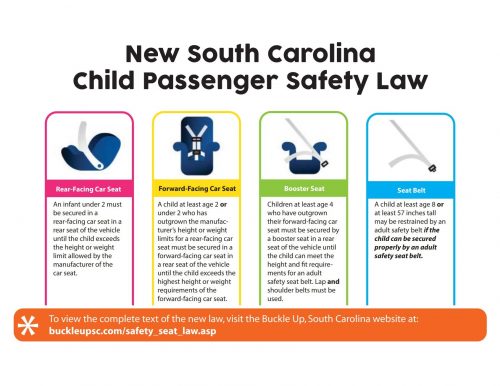
Motor vehicle crashes are the leading cause of death and injury for children over one year of age. When properly installed, child safety seats can reduce the risk of death by 71 percent for infants and 54 percent for toddlers. Seat belt usage increases the chances for surviving a crash by nearly 45 percent.
North Charleston Fire Department has partnered with Safe Kids Worldwide, Lowcountry Chapter, SCDHEC and local emergency departments to provide car passenger seat (CPS) checks for families at no cost. The goal of the program is to prevent and reduce injuries, disabilities and death to children due to motor vehicle crashes by:
- Counseling parents and community groups on child passenger safety.
- Demonstrating and instructing the proper installation of the various child safety seats (infant, convertible, and booster seats).
- Explaining the dynamics of a motor vehicle crash and potential dangers for children not properly restrained.
- Providing technical assistance as needed.
- Serving as a resource for addressing child passenger safety issues in the community.
- Stressing and educating the importance of safe transportation for children riding in motor vehicles
Appointments
Car seat installations are by appointment only. To schedule an appointment, please call Laura Kondor, Fire & Life Safety Educator, at (843) 740-2647. Appointments are available from 8:30am – 4pm Monday through Fridays.
What you will need:
- Please bring your car seat manual, vehicle manual.
- Knowledge of child’s height and weight, if born.
- Each appointment lasts 30 to 40 minutes to allow for inspection of seat, installation, and required educational information.
- If you are expecting a baby, it is best to schedule your appointment for at least one (1) month prior to the anticipated due date.
**The North Charleston Fire Department does not provide car seats or discard old car seats.**
Car Seat Technicians Outside NCFD Area
Please see the contact information below or this link (Inspection Stations_May2021) for the agencies who have certified car seat technicians:
Child Passenger Seat Installation Guides
- Rear Facing Installation
- Forward Facing Car Seat Installations
- Booster Car Passenger Seat Installation
SC Child Passenger Safety Law

ARTICLE 47.
CHILD PASSENGER RESTRAINT SYSTEM
SECTION 1. Section 56-5-6410 of the 1976 Code is amended to read:
“Section 56-5-6410. (A) Every driver of a motor vehicle (passenger car, pickup truck, van, or recreational vehicle) operated on the highways and streets of this State when transporting a child under eight years of age upon the public streets and highways of the State must properly secure the child in the vehicle as follows:
(1) An infant or child under two years of age must be properly secured in a rear-facing child passenger restraint system in a rear passenger seat of the vehicle until the child exceeds the height or weight limit allowed by the manufacturer of the child passenger restraint system being used.
(2) A child at least two years of age or a child under two years of age who has outgrown his rear-facing child passenger restraint system must be secured in a forward-facing child passenger restraint system with a harness in a rear passenger seat of the vehicle until the child exceeds the highest height or weight requirements of the forward-facing child passenger restraint system.
(3) A child at least four years of age who has outgrown his forward-facing child passenger restraint system must be secured by a belt-positioning booster seat in a rear seat of the vehicle until he can meet the height and fit requirements for an adult safety seat belt as described in item (4). The belt-positioning booster seat must be used with both lap and shoulder belts. A booster seat must not be used with a lap belt alone.
(4) A child at least eight years of age or at least fifty-seven inches tall may be restrained by an adult safety seat belt if the child can be secured properly by an adult safety seat belt. A child is properly secured by an adult safety seat belt if:
(a) the lap belt fits across the child’s thighs and hips and not across the abdomen;
(b) the shoulder belt crosses the center of the child’s chest and not the neck; and
(c) the child is able to sit with his back straight against the vehicle seat back cushion with his knees bent over the vehicle’s seat edge without slouching.
(5) For medical reasons that are substantiated with written documentation from the child’s physician, advanced nurse practitioner, or physician assistant, a child who is unable to be transported in a standard child passenger safety restraint system may be transported in a standard child passenger safety restraint system designed for his medical needs.
Any child restraint system of a type sufficient to meet the physical standards prescribed by the National Highway Traffic Safety Administration at the time of its manufacture is sufficient to meet the requirements of this article.
(B) For the purposes of this section, any portion of a recreational vehicle that is equipped with temporary living quarters shall be considered a rear passenger seat.”
Vehicle child restraints, vehicles lacking rear passenger seats, rear seating capacity exceeded
SECTION 2. Section 56-5-6420 of the 1976 Code is amended to read:
“Section 56-5-6420. If a motor vehicle lacks a rear passenger seat or if all of its rear seating positions are occupied by children under eight years of age, a child under eight years of age may be transported in the front seat of the motor vehicle if the child is secured properly in an appropriate child passenger safety restraint system or belt-positioning booster seat as described in Section 56-5-6410(1), (2), or (3).”
Time effective
SECTION 3. This act takes effect upon approval by the Governor.
Ratified the 15th day of May, 2017.
Approved the 19th day of May, 2017.
